No, I did not go to Washington D.C. today, but rather to The Great Dismal Swamp, where I explored, by bike, The Dismal Swamp Canal Trail. This relatively new trail is actually the old Rte. 17 that runs through here into North Carolina and other points south. When a new, safer 17 was built, people with vision decided to turn the old tree-lined road into a recreational trail, straight and flat for easy biking. It parallels an older route opened in 1805, that of the canal, which was hand dug by slaves through the eastern edge of the swamp. The Dismal Swamp Canal connected the port of Norfolk with northeastern North Carolina, facilitated decades of lumber extraction, and offered an inland alternative to the unpredictable Atlantic.
Even though I was in a swamp, it was evident that the area is in the midst of a severe drought. However, the edge of the trail offered a surprising number of late summer blooms. There were huge blue swaths of Wild Ageratum (Conoclinium coelestinum), some of it mixed with Goldenrod (Solidago).
Wild Ageratum also offered a nice background to the bolder color of American Beautyberry (Callicarpa americana).
There were a couple of wildflowers I did not immediately recognize. I think this is Evening Primrose (Oenothera biennis) ...
... and this may be Slenderleaf False Foxglove (Agalinis tenuifolia). I hope someone will let me know if my ID is wrong.
I posted a picture of Passiflora lutea for this month's Bloom Day post and noted its weediness. I have also grown Passiflora incarnata (pictured below), which while showier, is just as weedy, but more difficult to pull up.
The Great Dismal Swamp is perhaps better known for its animal communities. There is a sizable population of black bears, as well as over 20 snake species, including all three of Virginia's venomous ones. Fortunately all I saw were birds and a disinterested rabbit.
There are still a few reminders of busier times on the canal. The building below is the house where the toll taker lived. It is right on the edge of the water and the back half will likely be in the water given a strong enough wind. Hopefully some funding will be secured to preserve it, but it is fairly far gone.
These days the canal is used mostly by pleasure boats travelling between the Chesapeake Bay and the sounds of North Carolina.
Sailors in another age would put this swamp's water in barrels to drink on ocean voyages. The acids and tannins from tree bark inhibited the growth of bacteria making it safe to drink long after it was put on board. Even though too many of its trees have been felled, and much of the land that was once part of The Great Dismal Swamp has been ditched and drained for soybeans and tract houses - the water still retains its characteristic strong tea color.
September 17, 2010
Subscribe to:
Post Comments (Atom)
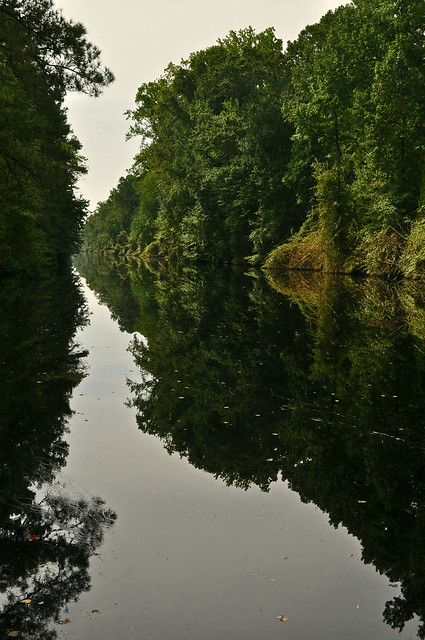


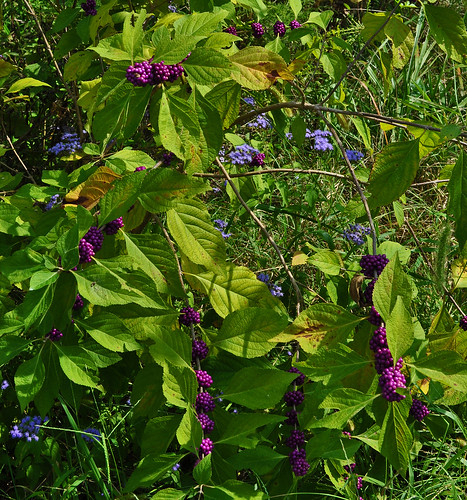


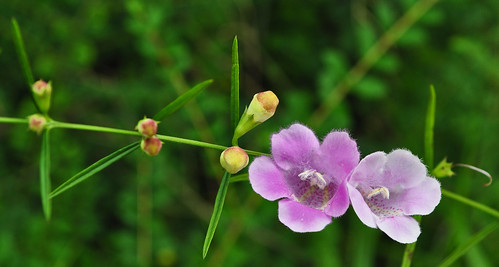




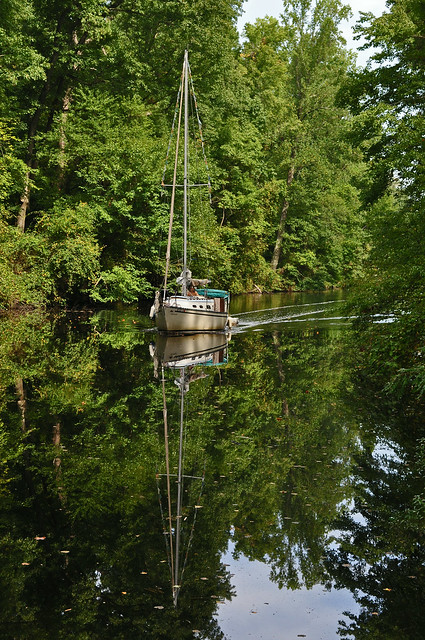
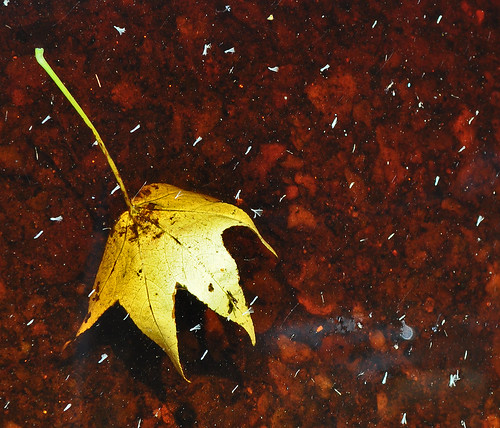




Great post! I love, love, love those WIld Ageratum pics...so lovely...especially paired with the goldenrod. You have to appreciate the foresight of people to re-use that route as a trail...nice!
ReplyDeleteLes,
ReplyDeleteI don't know Slenderleaf False Foxglove you might be right. My first impression was a Gerardia species. Enjoyed this post and the photos. That Blue Mist Flower has a lot of rare butterflies on it in the swamp this time of year.
I agree with Randy that's Gerardia. Beautiful pictures Les!
ReplyDeleteScott,
ReplyDeleteI was very thankful a group of people thought to make this into a park. It was a great ride.
Randy and Sweetbay,
Thanks for helping me ID this flower. All three of us are right. It seems they have changed Gerardia to Agalinis.
Les
This post throws up a lot of questions. That bear warning sign: you don't mention the bullet holes. Is that a run of the mill occurrance?
ReplyDeleteAnd are you safer on a bike? I mean, do bears run? Are they fast? Is Dismal the official name?
You all seem to take the possible presence of bears very lightly.
The natural herbaceous borders are wonderful. All those plants are highly prized here and the thought of them growing wild is exhilirating.
Hi, Les, Such beautiful photos! That looks like a very interesting place. I love the ageratum. Thanks! :)
ReplyDeleteJo,
ReplyDeleteSo many questions you have.
Yes bullet holes are a common occurence on many rural road signs. Moving target practice perhaps.
The bears are very cautious and avoid humans, but do occasionally wander from their home and end up in suburbia. I have never heard of an incident where a bear hurt a human in this area, unfortunately its usually the other way around. They are numerous enough for the refuge to hold a hunt for up to 20 a year, so all those guys shooting road signs can shoot at something else.
Yes the name is correct, in fact it is The Great Dismal Swamp. Great because it originally encompassed over 600,000 acres, but now has been pared down to about 100,000.
Ruth,
Thanks for stopping by, and yes the Wild Ageratum was beautiful.
Les
Wild ageratum! Beautiful wildflower photos Les! Quite the name for such a place of beauty. Dismal. I would bet there are are were tons of mosquitos... that could make it dismal. ;>)
ReplyDeleteSo NOT dismal - love all the images you captured. Amazing how much is in bloom (and berry) this time of year.
ReplyDeleteYour photos are always so beautiful, and I really enjoy your travelogues. Thanks for taking us to this place I'd never heard of. It's definitely not dismal.
ReplyDeleteGorgeous images. What a wonderful selection of wild flowers. A habitat rich in both flora and fauna, but...
ReplyDeleteThe bullet holes in the sign sent images of Deliverance into my head. I would be less afraid of the black bears than the guys with the guns.
Les,the swamp is on my short list of places to explore with my birding friends. How glorious it was through your pics. I always learn something new from your posts.
ReplyDeleteSo many interesting and heartening ideas this post brings up, especially repurposing the old highway for what must be an amazing bike ride. I can see that name, The Great Dismal Swamp, in elaborate calligraphy on old exploring maps. Your post really sparked an interest to learn more about this amazing waterway.
ReplyDeleteThanks for the post! This brings back many memories of canoeing and kayaking into Lake Drummond down that canal. No bears, but a few water moccasins. Then there was the hummingbird nest and the paw paws! A great day trip!
ReplyDeleteI'm trying to remember the name of the campground in Deleware/Maryland on the way to Ocean City. I remember the cypress trees and the lovely tea-colored water.
ReplyDeleteI don't usually get around to learning plant names, but your evening primrose reminds me of my own backyard wildflower which is a Hooker's primrose. Looks pretty much the same.
Thanks for the great tour!
Les, your wonderful photos always beg for much of my attention, and too I appreciate and enjoy the history you provide.
ReplyDeleteWe are already into fall here with cooler nights and more than an average amount of rainfall... and will try to send some your way. Crazy year re weather. Have a great week Les.
les, the great dismal swamp has been on my list of places to visit since i first heard of it. it is quite a drive from charlotte - i will just enjoy your lovely preview for now. beautyberry and ageratum are plants i wouldnt have thought to put together in the garden, but how pretty they are!
ReplyDeleteFamiliar plants! This time of year they all are flowering along our roadsides as well. Did you get eaten up? Looks like prime mosquito country!
ReplyDeleteLes, I am so happy to have found your blog. Your posts are full of interesting information (drinkable swamp water?) and your photography is superb (stunning pics of the canal). I will visit often. Pam
ReplyDeleteCarol,
ReplyDeleteI am not sure the name is apt today, but perhaps 300 years ago it was another story when life was hard even in the gentlest of lands.
Cyndy,
I was surprised how many blooms where there considering the drought we have been in.
Pam,
You are welcome, I like travelling with company.
GWGT,
I think the bullet holes are from when this place was yet a park, but no longer a road. Abandoned places have a way of drawing rowdy types.
Anne,
You should definately visit with birding friends. You would likely see and hear more birds if you went to the Washington Ditch trail. It is much further from busy roads and will lead to Lake Drummond.
Joanne,
I was longing the whole time for a kayak.
Weeping,
In Maryland just over the line from Virginia, near Ocean City is the Pocomoke River State park, and it is famous for bald cypress trees and dark waters. It's just a guess.
Di,
Thank you for your kind comments. We are still in the grips of very dry weather. I cut the grass tonight for the first time in a month and sent aloft a dust cloud of epic proportions.
Daricia,
Mother Nature has her own color scheme, sometimes it works, sometimes not. And yes it would be quite a drive for you.
Jim,
I was amazed at the total lack of mosquitos. I did not even get a chigger, which is unusual for me.
Pam E.G,
Thank you so much for stopping by. You are welcome to visit at any time.
Les
Hey Les,
ReplyDeleteGreat info. Now that the weather is beginning to cool off I may try to get out there and do a little hiking. Glad you didn't run into any rattle snakes!
Thanks for the trail description. I didn't know about this one. I can do without the snakes but the rest of it looks really pretty.
ReplyDelete